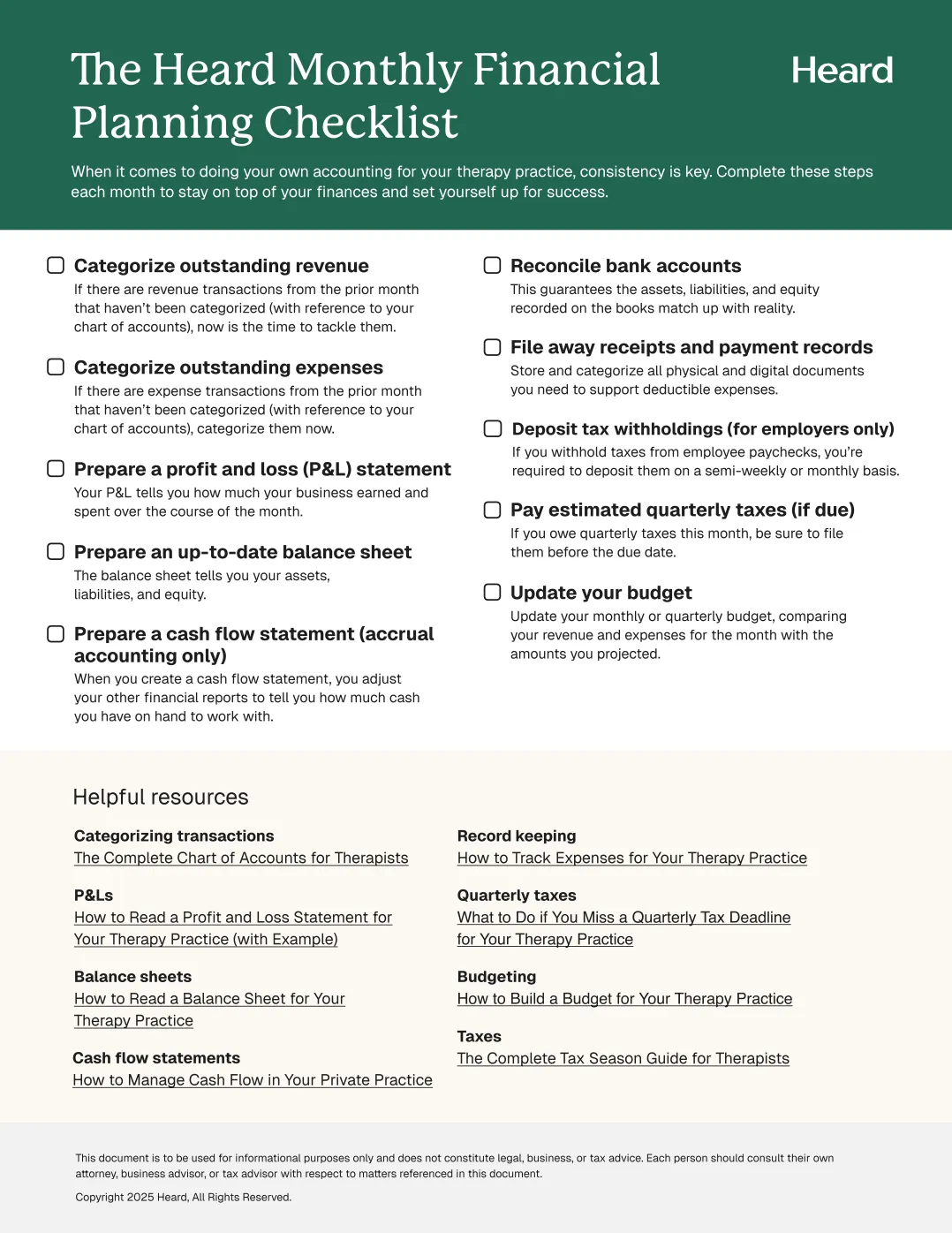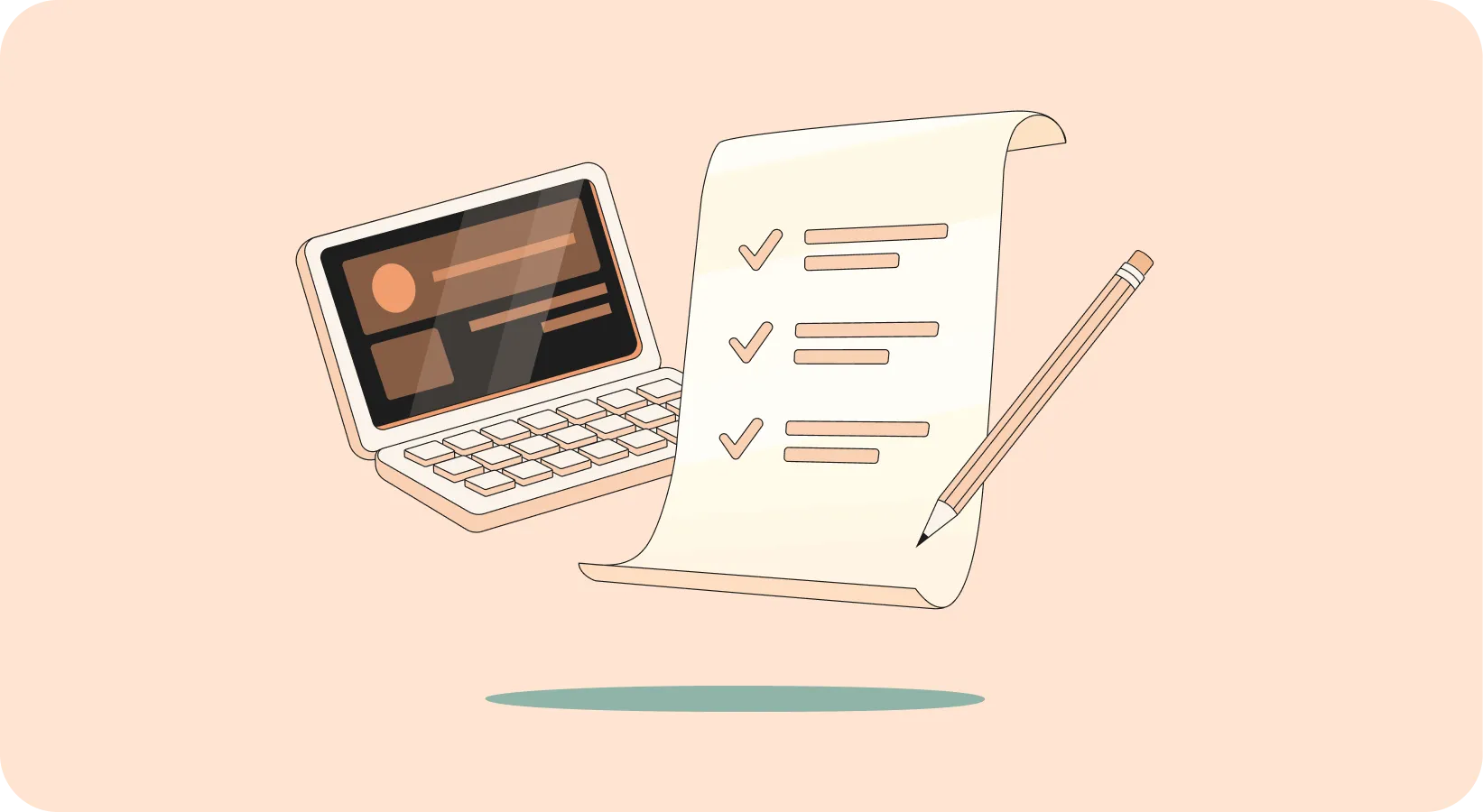If you’ve been researching accounting and bookkeeping for therapy practices, you may have stumbled across the terms cash basis and accrual. Or if you already do your own bookkeeping with software, you may have seen them on your financial statements.
That’s great. But what do they mean?
Whether you use cash basis or accrual accounting determines how your finances look on paper, and how you do your bookkeeping. Each has its pros and cons, and depending on which one you’re using, you could get a completely different picture of your business.
We’ll cover the main differences between these two methods of accounting, and help you choose the best one for your therapy practice. But first, a side-by-side comparison.
{{resource}}
What are cash basis and accrual accounting?
When you use cash basis accounting for your therapy practice, you record income on the books the moment you receive payment. And you record an expense on the books the moment you pay it.
When you use accrual basis accounting for your therapy practice, you record income as soon as you charge for it—even if you haven’t been paid yet. And as soon as you incur an expense, you record it on the books, even if you haven’t paid it yet.
C corporations and companies earning over $25 million in revenue are required by law to use accrual accounting.
Whether you choose cash basis or accrual, once you’ve decided on an accounting method, it’s tricky to change from one to the other. Doing so may require a lot of historical bookkeeping, and help from a professional. So, it’s a good idea to make an informed choice now, and stick with it.
Accrual vs. cash basis: an example using income
Let’s say you have a regular client who you bill on a per-session basis. The cost of each session is $90. Your client comes in for a session on May 31, and they pay with credit card via Stripe at the end of the session. Stripe payments typically take two days to pay out after they’ve been charged.
Using the accrual method, you don’t wait for the money to arrive in your bank account. The moment the client pays by card, you record the payment of $90 on the books
As a result, when you prepare your balance sheet for the month of May, that $90 will be included as an asset. You can look at your balance and know that it includes every dollar you charged clients in May.
Using the cash basis method, after the client pays, you don’t record it on the books. The payment is still being processed by Stripe, and the money hasn’t arrived in your bank account yet.
The money doesn’t arrive until April 2nd. At that point, you record it on the books. Since you’re recording the money in April, the income will be included on your April balance sheet. It won’t be included on your May balance sheet.
When you look at your balance sheet for May, you’ll know that it includes all income you received from clients—but not necessarily everything you charged clients.
Accrual vs. cash basis: an example using an expense
Suppose you pay a part-time assistant $1,000 per month to manage your emails and calendar. Your assistant invoices you on the 15th of every month, with payment due 14 days later. You’ve made it a habit to pay your assistant at the end of every month.
On May 15th, your assistant sends you an invoice for $1,000. But it’s a hectic month, and somehow you forget to pay the bill. Your assistant sends you a friendly reminder on June 1st. You apologize profusely and pay them right away.
Using accrual accounting, you would record your assistant’s pay of $1,000 on May 15th, the day they invoice you, as accounts payable (covered below).
When you prepare a balance sheet at the end of the month, it will include all of your liabilities. That $1,000 will be a part of them—you still owe your assistant the money.
Using cash basis accounting, you record expenses only when the money leaves your account. So, when your assistant invoices you on the 14th, you don’t record it on the books.
Accordingly, when the end of the month rolls around and you prepare a balance sheet for May, that $1,000 owing still hasn’t been recorded. Your total liabilities, as reported on your balance sheet, doesn’t include it.
{{resource}}
Cash basis vs. accrual: Key differences
There are a few specific ways your monthly bookkeeping differs based on which method you use.
Accounts receivable
When you use accrual accounting, you have an account (listed in your chart of accounts) called accounts receivable. All money you are owed, but haven’t collected yet, is listed under accounts receivable as an asset.
An asset is something that adds value to your business. Once you collect the money, the amount in your books is moved from accounts receivable to a different account called retained earnings.
When you use cash basis accounting, you don’t have accounts receivable. Money you earn is recorded as revenue when you only once you receive it, not when you send your client the bill.
Accounts payable
You can think of accounts payable as accounts receivable reversed. When your practice owes money, it’s recorded under accounts payable as a liability.
At the same time, it’s recorded as an expense under an expense account. For instance, if you hire a contractor to redecorate your office, once they send you an invoice, you record the amount as a liability under accounts payable, and as an expense under an account called office maintenance (or something similar).
Once you pay the bill, the amount is recorded as leaving your bank account, and effectively being removed from your accounts payable.
Bank reconciliation statements
When you use the accrual method of accounting, you (or your bookkeeper) produce regular bank reconciliation statements.
These statements compare the cash you have in your bank account to the cash recorded on the books. This is important because the accrual method a) records revenue when you bill a client, not when you’re paid, and b) records expenses when you’re billed, not when you pay.
Bank reconciliation statements help you make sure you’re actually getting paid, and that you’re actually paying your bills—so nothing slips through the cracks.
Cash flow statements
Similar to bank reconciliation statements, cash flow statements help you keep in touch with reality when you use the accrual method.
Your profit and loss statement for a particular month tells you how much money you made and how much you spent during that month.
Since the accrual method tracks income and expenses when they’re earned and when they’re incurred, respectively, you need a separate statement to see how much cash changed hands.
Without a cash flow statement, you’d run the risk of trying to spend money you don’t actually have, or trying to collect money you’ve already received. That’s why cash flow statements are an essential component of accrual accounting.
Cash basis: Pros and cons for your therapy practice
Having seen some of the extra work—and extra financial statements—the accrual method demands, you may be inclined to use cash basis accounting. But it’s important to weigh all the benefits and drawbacks before making a final decision.
Cash basis pros
- Simplicity. Fewer financial statements, plus no accounts receivable or accounts payable, means less time spent bookkeeping.
- Cash flow. True to its name, cash basis accounting is directly in tune with the money entering or leaving your business. If revenue or expenses show up on the books, you never have to worry whether money has changed hands yet.
- Single-entry bookkeeping. When you use cash basis accounting, you set up a simple single-entry bookkeeping system. For just about anyone who knows how to read a bank statement, single-entry bookkeeping is easy to understand—it won’t take much extra research to figure out how to do your own books.
- Easier to DIY. Using cash basis, it’s easier to do your own bookkeeping, without hiring a professional bookkeeper.
Cash basis cons
- Less insight. There are a lot of things you don’t see when you use cash basis accounting. For instance, your cash basis books won’t tell you how much time, on average, elapses between billing clients and getting paid. That means you have less insight into how your practice runs, making it harder to improve how you operate.
- Single-entry bookkeeping. It’s a double-edged sword. Yes, single-entry is simpler. But it opens you up to a host of potential errors. And its simplicity is one of the reasons you have less insight into how your practice runs.
- The DIY trap. Many therapists start out doing their own bookkeeping using the cash basis method. And it’s only when they fall six months behind on their bookkeeping—or make a costly error preparing a tax return—that they realize they need professional help.
{{resource}}
Accrual: Pros and cons for your therapy practice
The accrual method gives you a deeper insight into your practice’s inner workings at the cost of added complexity.
Accrual pros
- Operations oriented. The accrual method tracks money when you do the work to earn it. You can look at your accrual books and see exactly how many billable hours you worked over a particular period, and how much money you earned as a result.
- Easier planning. When you picture next month at your practice, do you picture the money being deposited in your bank account, or do you picture the clients you’re going to see and the work you’re going to do? Since they’re tied to operations, accrual books make it easier to project into the future, planning when you’re going to work, and how many hours.
- Deeper analysis. Using the accrual method, you get more insight into how your business earns money over time, so you can find ways to help your practice flourish.
Accrual cons
- More ledger entries and financial statements. If you’re still doing your own bookkeeping, using the accrual method will likely eat up more of your time.
- Hiring a bookkeeper. Because of the time it demands, as well as its complexity, accrual accounting is usually best left to professionals. If you’re not prepared to hire a bookkeeper, it may not be a good choice for your practice.
Which accounting method is best for your therapy practice?
If your therapy practice is brand new, your client list is still short, and you don’t have many regular business expenses, you can get away with using cash basis accounting. It will make it easier to do your own bookkeeping using spreadsheets or accounting software.
But, for most therapy practices, accrual accounting is the best option. It gives you more insight into how your practice runs, helps you plan for the future, and it’s the method preferred by most professional bookkeepers.
Even if it may mean hiring a professional, accrual accounting is heavier on the details than cash basis. And when it comes to your practice’s financial health, it’s better having too much information than too little.
—
Need help handling the financial side of your therapy practice, but not sure who to turn to? Learn about the difference between accountants and bookkeepers.
This post is to be used for informational purposes only and does not constitute legal, business, or tax advice. Each person should consult their own attorney, business advisor, or tax advisor with respect to matters referenced in this post.
Bryce Warnes is a West Coast writer specializing in small business finances.
{{cta}}
Manage your bookkeeping, taxes, and payroll—all in one place.

Discover more. Get our newsletter.
Get free articles, guides, and tools developed by our experts to help you understand and manage your private practice finances.





